A) the supply of tablets increases.
B) the price of a tablet decreases.
C) the marginal cost of a tablet decreases.
D) the price of a tablet increases.
Correct Answer

verified
Correct Answer
verified
Multiple Choice
One of the problems associated with the utilitarianism is that it does NOT recognize that
A) taxing those with higher incomes results in less work effort.
B) each individual receives a different marginal benefit from a dollar's worth of income.
C) equity is achieved when there is no poor and no rich.
D) similar individuals should be treated the same.
Correct Answer

verified
Correct Answer
verified
Multiple Choice
If a person will rent an apartment only to married couples over 30 years old, that person is allocating resources using a ________ allocation method.
A) first-come, first-served
B) market price
C) personal characteristics
D) command
Correct Answer

verified
Correct Answer
verified
Multiple Choice
When scarce resources can serve only one user at a time in sequence, which method works well for allocating the scarce resources?
A) first come, first served
B) lottery
C) contest
D) command system
Correct Answer

verified
Correct Answer
verified
Multiple Choice
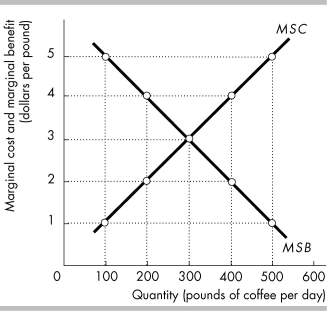 -The above figure shows the marginal social benefit and marginal social cost curves of coffee in the nation of Kaffenia. For a consumer, the price they are willing to pay for each additional pound of coffee is
-The above figure shows the marginal social benefit and marginal social cost curves of coffee in the nation of Kaffenia. For a consumer, the price they are willing to pay for each additional pound of coffee is
A) always less than the economy's marginal social cost of producing that additional pound.
B) equal to their own marginal benefit from consuming that additional pound.
C) equal to their consumer surplus.
D) Both answers B and C are correct.
Correct Answer

verified
Correct Answer
verified
Multiple Choice
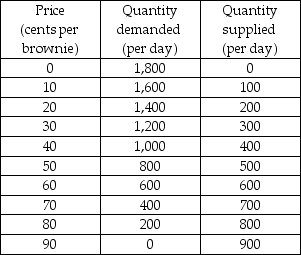 -In the above table, the efficient quantity of brownies is produced when the price of a brownie is equal to
-In the above table, the efficient quantity of brownies is produced when the price of a brownie is equal to
A) 0.
B) 40¢.
C) 60¢.
D) 80¢.
Correct Answer

verified
Correct Answer
verified
Multiple Choice
Marginal cost is
A) the same as the marginal benefit because producers benefit from the money they receive when they sell the good.
B) the opportunity cost of producing one more unit.
C) the total opportunity cost of producing all the units of the good.
D) zero at the efficient level of production.
Correct Answer

verified
Correct Answer
verified
Multiple Choice
Four people each have a different willingness to pay for one unit of a good: George will pay $15, Glen will pay $12, Tom will pay $10, and Peter will pay $8. If price decreases from $9 to $8 then the consumer surplus from this unit will increase by
A) $3.
B) $4.
C) $2.
D) $1.
Correct Answer

verified
Correct Answer
verified
Multiple Choice
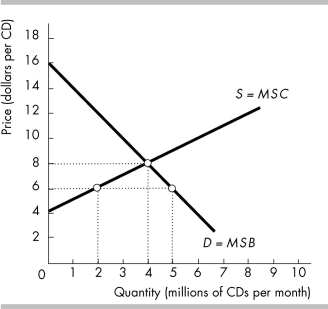 -In the above figure, if five million CDs per month are produced and consumed, that is
-In the above figure, if five million CDs per month are produced and consumed, that is
A) better than producing and consuming four million CDs because more is always better than less.
B) more than the efficient quantity because the marginal social benefit exceeds the marginal social cost.
C) more than the efficient quantity because the marginal social cost exceeds the marginal social benefit.
D) less than the efficient quantity because the opportunity cost exceeds the marginal social benefit.
Correct Answer

verified
Correct Answer
verified
Multiple Choice
Which of the following statements about supply curves is CORRECT? I. A supply curve also can be a marginal cost curve. II) A supply curve tells the quantity of other goods and services that sellers must give up to produce another unit of the good.
A) I only
B) II only
C) both I and II
D) neither I nor II
Correct Answer

verified
Correct Answer
verified
True/False
Although the efficient quantity to produce of any good is located where marginal social benefit and marginal social cost are equal, there will usually be other quantities where the sum of consumer and producer surplus are greater.
Correct Answer

verified
Correct Answer
verified
Multiple Choice
In the United States, resources are most often allocated by
A) market price.
B) command system.
C) lottery.
D) contest.
Correct Answer

verified
Correct Answer
verified
Multiple Choice
Marginal benefit
A) is the same as the total benefit received from consuming a good.
B) is the maximum amount a person is willing to pay for one more unit of a good.
C) increases as consumption increases.
D) is the difference between total benefit and total cost.
Correct Answer

verified
Correct Answer
verified
Multiple Choice
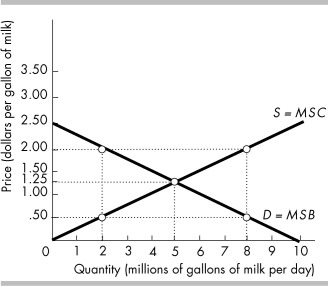 -In the above figure, the efficient quantity of milk is
-In the above figure, the efficient quantity of milk is
A) 10 million gallons per day.
B) 5 million gallons per day.
C) zero gallons per day.
D) None of the above because all of the quantities are efficient.
Correct Answer

verified
Correct Answer
verified
True/False
Buyers receive a consumer surplus when the price exceeds the marginal benefit.
Correct Answer

verified
Correct Answer
verified
Multiple Choice
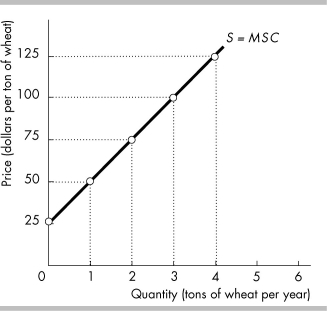 -In the above figure, the second ton of wheat would be produced even though the producer surplus on it is zero if the price per ton of wheat was
-In the above figure, the second ton of wheat would be produced even though the producer surplus on it is zero if the price per ton of wheat was
A) $25.
B) $50.
C) $75.
D) $100.
Correct Answer

verified
Correct Answer
verified
Multiple Choice
Resource use is efficient when production is such that marginal social benefit is
A) greater than marginal social cost.
B) equal to marginal social cost.
C) less than marginal social cost.
D) at its maximum value.
Correct Answer

verified
Correct Answer
verified
Multiple Choice
A market demand curve can be constructed by
A) adding the prices all consumers will pay for any given quantity.
B) adding the quantities that all consumers buy at each price.
C) adding the quantities that a consumer buys at the highest price.
D) None of the above answers is correct.
Correct Answer

verified
Correct Answer
verified
Multiple Choice
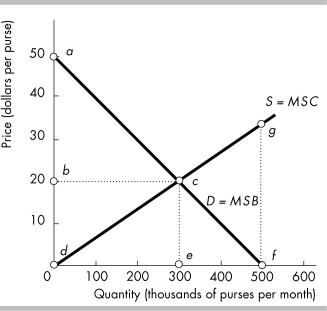 -In the above figure, the total producer surplus at the efficient level of output is
-In the above figure, the total producer surplus at the efficient level of output is
A) $4.5 million.
B) $9.0 million.
C) $2.5 million.
D) $3.0 million.
Correct Answer

verified
Correct Answer
verified
Multiple Choice
 -The above figure shows the marginal social benefit and marginal social cost curves of doughnuts in the nation of Kaffenia. At Kaffenia's efficient quantity of doughnuts
-The above figure shows the marginal social benefit and marginal social cost curves of doughnuts in the nation of Kaffenia. At Kaffenia's efficient quantity of doughnuts
A) total consumer surplus is zero.
B) total producer surplus is zero.
C) consumer surplus exceeds producer surplus by the greatest possible amount.
D) the sum of consumer surplus and producer surplus is maximized.
Correct Answer

verified
Correct Answer
verified
Showing 181 - 200 of 450
Related Exams